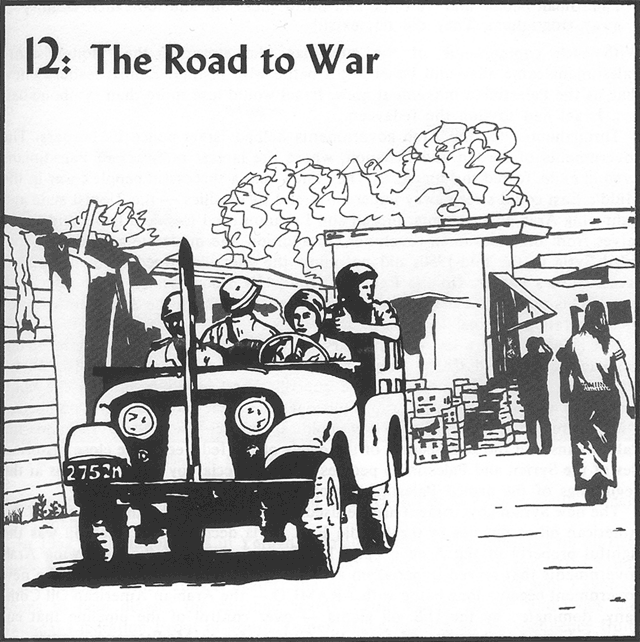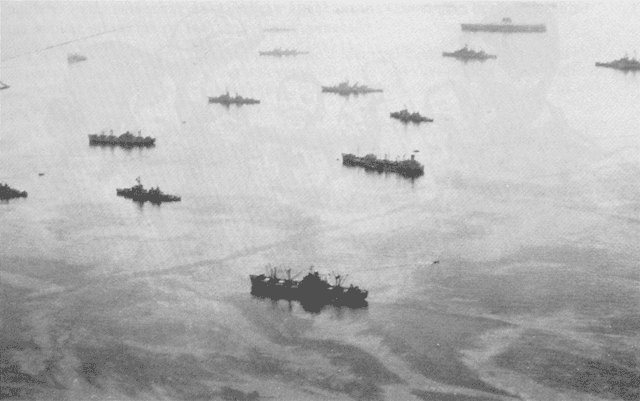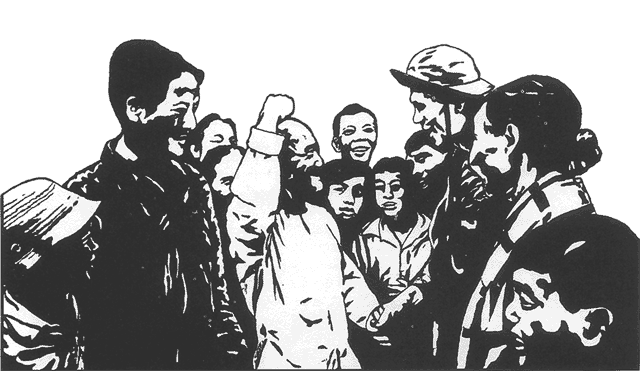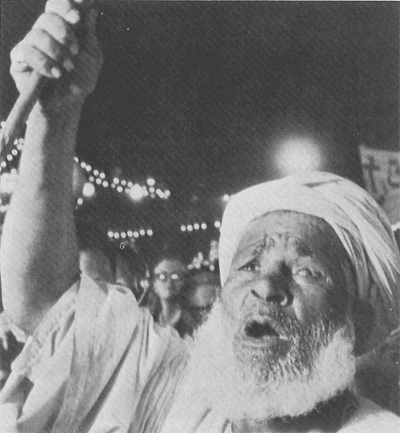Our Roots Are Still Alive - Chapter 12
Previous: Chapter 11
Table of Contents
Next: Chapter 13
New Jersey Solidarity-Activists for the Liberation of Palestine Main Site

- The United States and Israel employ almost identical language in speaking of reprisal actions. The formula employed is that the cost must be made so high that those involved will no longer be willing to pay it.
- Moshe Dayan after trip to Vietnam as guest of U.S. Marines
The first Palestinian guerrillas who crossed the border into Israel lived up to the name fedayeen - "people of sacrifice." Most never expected to leave Israel alive. The well-equipped Israeli Defense Forces shot suspected guerrillas on sight. If the fedayeen made it back to Jordan, they often met death or prison at the hands of Hussein's border patrols.
At first, the fedayeen did not pose a major military threat to Israel. But they did shake a central political pillar of the Zionist state: the carefully nurtured myth that Palestine had been a "land without a people" until the Jews "returned" to it. Golda Meir summed up this view of history in an interview with the London Times:
- There were no such things as Palestinians. It was not as though there were a Palestinian people and we came and threw them out and took their country away from them. They did not exist.1
With each communique of the guerrillas, the story of the "non-existent" Palestinians came alive and Israel lost a battle with history. Zionist leaders knew that, as the Palestinian movement grew, Israel would lose more than symbolic battles. Israel had to stop the fedayeen.
Throughout 1965, the Arab governments helped Israel police its borders. The governments of Jordan and Lebanon, where the largest numbers of Palestinians lived in exile, feared the guerrillas. They knew that a successful people's war in the Middle East could sweep away imperialism and all its allies - the Zionist state and right-wing Arab governments. Jordan and Lebanon tried to shield Israel and themselves from the Palestinian revolution. In addition, the moderate government that ruled Syria in the mid-1960s did not allow the guerrillas freedom of movement across Syria's border. On the Egyptian front, UN troops sealed the border with Israel. This meant that the fedayeen had no reliable base in the Arab countries for their operations against Israel.
But in early 1966 a left-wing military government took power in Syria. It immediately announced that it would no longer act as a "guardian for Israel's interests." It opened its borders to the guerrillas and began to publish the communiques which the guerrilla groups put out after each operation. The number of raids increased dramatically. Their political impact grew as Syria and the Palestinians told the Arab people of the deeds of the fedayeen. The close historical ties of the Syrian and Palestinian peoples led to a special joy among Syrians at the beginnings of the armed Palestinian movement.
The new Syrian government also refused to be a guardian for the interests of the American oil companies in the Middle East. Syria declared that Arab oil was the rightful property of the Arab people. The Syrians criticized the right-wing Arab governments that served imperialism at the expense of the Arab people. The new government began a long battle with ARAMCO - the Arabian American Oil Company, dominated by the U.S. oil giants - over control of the pipeline that cut through Syria and brought oil from the Gulf states to Mediterranean ports.
Arab Nationalism on the Rise
The U.S. government and the American oil companies were alarmed. Tied down in Vietnam by a people's war, the United States could not easily fight revolution in the Middle East. Yet the American oil companies had an enormous stake in the area, and they wanted it protected. Middle Eastern oil made up 70 percent of the oil reserves of the non-socialist world. Sixty percent of the oil fueling the U.S. military machine in Vietnam came from the Middle East. Sales of Middle East oil brought in profits of $2 billion a year for U.S. corporations.
The major American military force in the area was the Sixth Fleet, which cruised the Mediterranean coast. One exuberant sailor said the mission of this imposing armada was to "steam around the millpond and scare the Arabs."2 This naval show of strength did not stop the Syrians, Palestinians and other Arab nationalists from fighting. As the Palestinian guerrillas continued their attacks on Israel, further south, in the Arabian peninsula, war raged in the countries of Yemen, South Yemen and Oman.
 The U.S. Sixth Fleet patrolling the Mediterranean
The U.S. Sixth Fleet patrolling the Mediterranean
In 1962 Arab nationalists in Yemen, a small country which bordered on oil-rich Saudi Arabia, declared a republic. The United States and Britain supported Saudi Arabian troops which fought against the new government. Nasser sent Egyptian troops to help defend the republic against Saudi attack. In the mid-1960s the National Liberation Front of South Yemen began fighting for independence from Britain. In 1966 the British announced plans to withdraw from Aden, the major port city in South Yemen. Guerrilla warfare also began in the adjoining province of Dhofar, Oman. The revolts in Yemen, South Yemen and Oman were a serious threat to Saudi Arabia and the U.S. oil companies there.
A high-level U.S. policy study of the Middle East in this period concluded that revolutionary Arab nationalism, which the study called "Nasserization," might well spread to Lebanon, Jordan and the Arabian peninsula. Thus it posed "a security crisis of major and possibly catastrophic proportions."3 With almost a million troops in Vietnam, the United States could not send its own troops to shore up its weakened allies. Yet something had to be done.
In 1966 the United States began arming Israel with new planes and missiles. While Israeli Foreign Minister Abba Eban was concluding a deal for Skyhawk missiles in the United States, James Feron of the New York Times reported on the developing U.S. strategy for the Middle East:
- The United States has come to the conclusion that it must rely on a local power - the deterrent of a friendly power - as a first line to stave off America's direct involvement. Israel feels she fits this definition.4
 The Vietnamese inspire revolutionary movements around the world.
The Vietnamese inspire revolutionary movements around the world.
Crisis in Israel
Israel was finally to play the role of watchdog for the United States. To the hardline Zionist leaders, the chance had come none too soon. The Palestinian raids were no longer simply a nuisance. The guerrillas were ambushing border patrols, blowing up bridges, and harassing the para-military border settlements. They were beginning to attack larger military and economic targets as well.
The upsurge in fedayeen raids came at a time of growing economic problems in Israel. The number of new immigrants was falling off rapidly. In 1966 just as many people left Israel for other countries as came to the Jewish state. A popular joke in Israel that year described a sign hanging in Israel's Lod Airport. The sign read: "Will the last person leaving kindly turn out the lights?" Zionist leaders did not find the joke terribly funny. They knew the stark reality behind this new exodus. The vital aid from the West that sustained Israel was drying up. German reparations payments ended in 1965 and even sales of Israeli bonds - a source of $3.5 billion since 1948 - had begun to slip. The result was rising taxes and prices and high unemployment - all of which were driving more and more people from the country. As long as the Arab boycott of Israel continued to stop normal trade between Israel and its neighbors, the Israeli economy could not solve these problems.
Thus when the U.S. government most needed a watchdog to guard its interests in the Middle East, the leaders of Zionism were more than anxious to do the job and to reap the benefits. The enemies of the oil companies and the U.S. government were also the enemies of the state of Israel: Syria, the Palestinians, Nasser and revolutionary Arab nationalists throughout the area. Israel would punish them for their acts against the United States and the Jewish state. Zionist leaders knew that the U.S. government would show its appreciation.
In March 1966, General Moshe Dayan toured Vietnam as a guest of the U.S. military. After witnessing an American attack on the Cambodian border, he noted the similar strategies of U.S. and Israeli generals:
- The United States and Israel employ almost identical language in speaking of reprisal actions. The formula employed is that the cost involved in aiding the enemy ... must be made so high that those involved will no longer be able to pay it.5
That summer the new Syrian government began to pay the price for its support of the Palestinians and its defiance of the United States. As the fedayeen stepped up their attacks, Israeli troops began regular "reprisal raids" across the Syrian border. After a flurry of guerrilla operations in early July, the Israeli Air Force bombed targets in Syria. The United States increased arms shipments to Israel. Syria continued to support the Palestinians.
In September the Israeli Army Chief of Staff, General Yitzhak Rabin, formalized Israeli policy:
- The Syrians are the spiritual fathers of the Al-Fatah group .... The military engagements which Israel has to conduct in Syria in reprisal for the sabotage raids she suffers are therefore directed against the Syrian regime .... Our aim is to make the Syrian government change its mind, and to eliminate the cause of the raids.6
A week later, Israel's Prime Minister Levi Eshkol made it clear that Syria would be held responsible for all Palestinian raids, no matter what country they came from.
The Syrians took Israel's threats seriously. They began urgent talks with Nasser. In November Syria and Egypt signed a mutual defense pact. The Egyptians hastened to add that the pact did not mean "that the Egyptian Army would immediately intervene against any Israeli attack on Syrian positions."7
The Israeli government and media ignored these disclaimers. They used the new pact to spread alarm among the Israeli people. It was not the defensive move of a nervous Syria and a reluctant Egypt, but a new act of aggression by the "bloodthirsty Arabs." Despite the cries of alarm, many Zionists were glad to see Nasser drawn into the conflict. They thought that if events were to lead to war, there was no sense in defeating only the Syrians. Nasser, the hero of the Arab world and leader of the most influential country, should be defeated as well. A sound trouncing of Syria and Egypt might finally force them to recognize Israel.
A few days after the signing of the Egyptian-Syrian pact, a mine exploded near the Jordanian border. It killed three Israeli soldiers and wounded six. The Israeli Prime Minister did not want to test the pact immediately by attacking Syria. Instead, he ordered a reprisal raid against the nearby Jordanian village of Sammou. Eighty Israeli tanks, covered by Mirage aircraft, moved across the border and leveled the village. The school, the hospital and one hundred twenty-five houses were reduced to rubble. The Israelis killed eighteen Jordanians and wounded one hundred thirty-five.8
The West Bank of Jordan, the home of many Palestinians living under the rule of King Hussein, exploded with violent demonstrations from Nablus to Jerusalem. Demonstrators demanded arms to protect themselves from Israel. They accused Hussein of weakness toward Israel and betrayal of the Palestinian people through harassment of the guerrillas. Hussein's regime was almost overthrown. His Arab Legion was able to restore order only by firing on the demonstrators and filling the jails with his opponents. Hundreds of Palestinians were killed or wounded.
To deflect the intense Palestinian anger from himself, Hussein accused Nasser of failing to act in the face of Israeli reprisals against another Arab country, and he ridiculed him for hiding behind the UN troops on Egypt's border. Hussein's verbal blasts did not divert Palestinian anger. But they did put more pressure on Nasser to take some action against Israel.
Nasser Enters the Conflict
In January 1967, the fedayeen began a new round of raids, stronger and more effective than those of the previous year. The Syrians and Israelis clashed regularly in the demilitarized zone on their common border. Some Zionist leaders demanded a reprisal raid against Syria. Shimon Peres, an ally of Ben-Gurion, said in an interview that the Syrians were the only antagonists "never to have felt any real blow from the Israelis." He added, "Perhaps the time has now come to teach the Syrians a good lesson."9
In April the Israelis defied the Syrians by cultivating land inside the demilitarized zone. Syrian gunners fired on an Israeli armored tractor and there were artillery exchanges across the border. Then Israel launched a major tank and air attack on Syrian border villages. Israeli planes shot down six Syrian MIGs and penetrated as far as the suburbs of the capital, Damascus. Again, Nasser did not respond and was ridiculed by Hussein and other Arab critics.
Israel's General Rabin said that he hoped the Syrians would understand "the lesson which has been administered to them." Personally, however, he thought it was "inadequate."10 In mid-May, he went a step further, saying, "[S]o long as the ardent revolutionaries in Damascus have not been overthrown, no government in the Middle East can feel safe."11 According to the Associated Press, a high-ranking Israeli army officer had threatened that Israeli troops might occupy Damascus to put an end to the acts of the fedayeen.
Rumors that Israel or the United States or both might attack Syria grew. The increased maneuvers of the Sixth Fleet off the Syrian coast did nothing to dispel Arab fears. There was intense pressure on Nasser to do something to protect Syria. The right-wing kings, Hussein of Jordan and Feisal of Saudi Arabia, rejoiced at Nasser's dilemma. They heaped abuse on him, calling him a dishonorable coward, afraid of Israel's shadow.12
Nasser did not want to fight Israel. One-third of the Egyptian Army was still tied down in Yemen. This was not the time to wage war with Israel. Yet he had to act. On May 15, amidst great fanfare, he sent Egyptian troops toward the Sinai Desert and the Israeli border. He hoped such a move would discourage Israel from attacking Syria, since the attack might lead to a war on two fronts.
No one took Nasser's action seriously. Although the Israeli leaders publicly denounced it as one more act of aggression, they knew that it was a symbolic gesture. The Syrians and Nasser's other critics were quick to condemn his "mini-mobilization" as minor saber-rattling. Hussein's Jordan Radio continued to accuse Nasser of hiding behind the UN troops.

Egyptian demonstrator supports Nasser's actions.
The next day Nasser publicly asked the United Nations to restation its observers on the border with Israel - another symbolic move. He was told he could not request any UN troop movement; he could only ask for the removal of all UN troops. It was an either/or choice, and Nasser was trapped. Unwilling to back down from his original request, he demanded the withdrawal of all UN troops from Egypt. Egyptian troops took up positions along the Israeli border. They also occupied Sharm-el-Sheikh, which overlooks the narrow Straits of Tiran, the only sea outlet for the Israeli port of Eilat. On May 23 Nasser closed the Straits of Tiran to Israeli shipping.
The Straits had been open to Israeli ships since the 1956 Suez war. Ben-Gurion had said of that war, "For us the main purpose of the Sinai campaign was to safeguard our southern sea route."13 The Israelis had withdrawn from Sharm-el-Sheikh very reluctantly and only with a guarantee that UN troops would keep the Straits open. By closing the Straits, Nasser was erasing the last humiliating reminder of Israel's drive into Egypt. His critics could not call this act cowardice.
No one did. The Israelis cried that the closure of the Straits meant "economic strangulation" for Israel. Israel demanded that the Straits be reopened. Although only 5 percent of Israel's foreign trade passed through the Straits, Israeli leaders now had their chance to call Nasser's bluff.
Despite Israel's verbal blasts, Nasser thought he could get away with his bold action. The Arab states applauded it. Everyone else seemed to be calling for restraint: the United Nations, the United States, and the Soviet Union. The United States assured Nasser through the Soviet Union that it was urging Israel to resolve the crisis peacefully. Nasser trusted the American assurance. For several days he proudly believed that he had spared Syria from an almost certain Israeli attack. He answered Israel's campaign of threats and warnings with a public show of bluster and toughness. Meanwhile, unknown to his audience, Nasser was trying to defuse the crisis through secret negotiations.
The Arab people greeted Nasser's public actions with heady rhetoric. Elated people filled the streets of Arab capitals, convinced that the long-awaited hour of victory over Israel was near. They thought Nasser had taken the first step toward war. The actual weakness of the Arab armies was ignored in what one Arab observer called a "mobilization of imagination." People gathered around radios, rejoicing as Nasser said, "If Israel wants to attack us, our answer is `You are welcome!"14
Many Arab radio broadcasts and newspapers described the coming demise of Israel in vivid detail. Ahmed Shukeiry, the PLO leader, broadcast over Cairo Radio the cry, "Drive the Jews into the sea!" Israel picked up the most menacing Arab statements and broadcast them to the listening West. Western media ignored Israel's own racist attacks and slurs on the Arab people. Zionist organizations in the United States played on the theme and created a vivid picture for Western audiences: a sea of barbarian Arabs threatened to engulf a small and valiant nation!
Pentagon computers told a vastly different story about the balance of forces. They predicted that no matter who struck first, in whatever combination of Arab forces, Israel's military superiority assured its victory. Nonetheless, on May 25 the Pentagon sent battalions of Marines to the Sixth Fleet in case they might be needed. A member of the Israeli Chiefs-of-Staff stated, "The Egyptians concentrated eighty thousand soldiers while we mobilized against them hundreds of thousands of men."15 Three days before Nasser announced the closure of the Straits of Tiran, Israel had already ordered a full mobilization of its troops. On May 30 Moshe Dayan, an ally of Ben-Gurion, took over as Minister of Defense. By June 2, the date of the attack was set. Israel was about to give Syria and Egypt the "lesson" it had promised. It only awaited U.S. approval. On June 4, as Nasser continued negotiations with an American envoy, President Lyndon Johnson telegraphed Dayan and gave Israel the final go-ahead from the United States.16
Footnotes
- London Times, 15 June 1969.
- New York Times, 19 June 1967, cited by Rita Freed, War in the Mid East (New York: 1972), p. 52.
- Eugene Rostow, "The Middle Eastern Crisis in the Perspective of World Affairs," International Affairs (April 1971), p. 280, cited in MERIP no. 21, p. 10.
- New York Times, 11 June 1966, cited by Schleifer, The Fall of Jerusalem, p. 95.
- Newsreel Films, "We the Palestinian People," 1973.
- Cited by Rodinson, Israel and the Arabs, pp. 180-181.
- Al-Ahram, 18 November 1966, cited by Rodinson, p. 181.
- Rodinson, p. 181.
- Rodinson, pp. 183-184.
- Ibid., p. 184.
- Tabitha Petran, Syria (New York: 1972), p. 198.
- The general source for material regarding events and analysis leading up to the outbreak of war is Schleifer, pp. 100-130 unless otherwise noted. Schleifer's chronology is based on Michael Bar-Zohar, Embassies in Crisis; Diplomats and Demagogues Behind the Six-Day War (New Jersey: 1970).
- Terence Prittie, Israel: Miracle in the Desert (New York: 1967), p. 71.
- Le Monde, 30 May 1967, p. 3, cited by Rodinson, p. 200.
- Ha'aretz, 19 March 1972, cited in The Other Israel, ed. Bober, p. 85.
- Ma'ariv, 3 May 1968, cited in The Other Israel, p. 84.